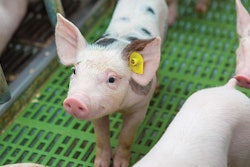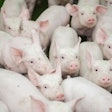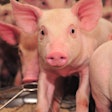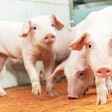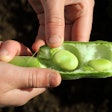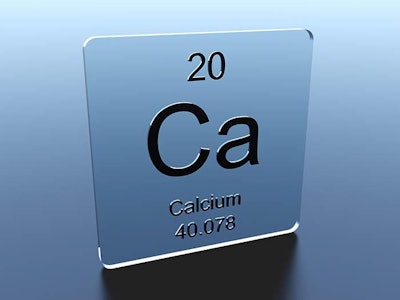
Calcium is rarely considered to be a limiting nutrient in pig feeds because it is abundant and cheap. Limestone and calcium carbonate – the two most common sources of calcium – are readily available, and at competitive prices. But there are cases where calcium deficiency or toxicity, or under- and over-supplementation, can occur, causing considerable problems. Despite its abundance and low price, calcium cannot be used without caution and, as it happens, this is the case as it is invariably being used as a common carrier for many products.
The role of calcium
More than 90 percent of all calcium in the body is found in bones and teeth. Thus, calcium is the most important mineral when it comes to skeletal development and maintenance. Non-skeletal functions, in the form of ionized calcium, include muscle contraction and relaxation (birth procedure in sows), nerve conduction, regulation on blood clotting, and cell signaling in immune responses. Clearly, calcium is an important nutrient, although not always recognized as much as in human nutrition and medicine.
Calcium requirements
Calcium requirements range from about 1 percent of complete feed for breeding gilts and sows, down to about 0.5 percent for finishing pigs. Research on this subject is quite old and unlikely to be updated, due to the lack of financial incentives. Several organizations occasionally publish their estimates based mostly on experience and common practice. For example, the British Society of Animal Science in 2003 published a guide on calcium specifications, which is presented in the following table, along with more recent requirement estimates from USA’s National Research Council (2012).
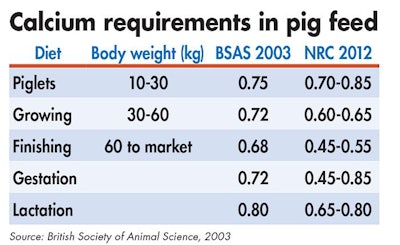
Calcium deficiency
A mild calcium deficiency will cause poor development of the skeletal system, resulting in an increased number of “broken backs” at the slaughterhouse (especially in pigs finished at very heavy weights), and in poor leg condition in aged sows. This is certainly a chronic problem caused by improper feed formulation and lack of taking into consideration actual feed intake, current performance levels, and other interacting factors, including the feed manufacturing system (for example, the degree of accuracy in weighing ingredients).
A severe deficiency, highly unlikely to occur under modern commercial production practices, is causing rickets (poorly developed bones causing malformation) in growing pigs and osteomalacia (brittle bones) in mature pigs. Such problems can occur when a feed mixing or formulation error happens due to negligence.
Calcium toxicity
Calcium toxicity is very rare and, again, it only occurs by accidental overdose due to a mixing or formulation errors. Pigs are quite resistant to calcium overdose, but a chronic toxicity will cause internal calcification of organs and growth stasis. Most problems are attributed to reduced absorption of phosphorus and zinc rather than hypercalcemia itself.
Calcium in piglet diets
Calcium carbonate and limestone have a very strong buffering capacity in that they can neutralize hydrochloric acid secreted in the stomach. This acid is the first step in the enzymatic breakdown of proteins and, with its suppression, undigested proteins pass onto the large intestine, where they can be used as “food” by pathogenic bacteria such as Salmonella and Collibacteria, causing severe diarrheas. To make matters worse, hydrochloric acid secretion is not fully developed in recently weaned pigs.
To this end, piglet diets should contain only enough calcium to sustain rapid growth, thus avoiding excesses, and in some cases even the traditional margins of safety employed in feed formulation should be omitted. Some early diets may even contain calcium at marginal levels verging close to 0.6 percent, which are only acceptable because other ingredients contain unaccounted amounts of calcium bringing total calcium closer to 0.8 percent. Sow’s milk contains about 1 percent calcium, so a level between these two extremes is deemed sufficient for post-weaning diets.
Calcium in sow diets
Most diets for developing gilts and breeding sows (gestating, dry and lactating) do not contain adequate calcium. With the major cause of sow culling being leg problems, it is logical to assume that sound development of bone structure should be of paramount importance from an early age. Yet this is rarely the case.
Instead, most developing gilts receive calcium levels suitable for growing-finishing pigs, but clearly inadequate for long-term bone development. As such, they enter the reproductive cycle with a weak or rather under-developed skeleton system. Overfeeding during gestation, a common problem, offers little in terms of improving bone development at an early age as most gestating diets are usually low in calcium. In addition, fat sows during lactation exhibit poor feed intake, causing substantial loss of calcium from the bones, which is very hard to replace as sows age.
Calcium is also involved in the initiation of milk production in recently farrowed sows. Manipulation of calcium supplementation right before and after farrowing has shown to increase milk yield during the first week of lactation. Special products for this purpose have shown their value under commercial conditions, but they are not widely known.
Calcium and phosphorus
Calcium and phosphorus are required in many common biological functions, but in the gastrointestinal tract they act as antagonists. Thus, an oversupply of one causes reduced absorption of the other. This is mostly a problem with phosphorus, which is always limiting as it is more expensive, but diets marginal in calcium (by design or accident) can be detrimental for reproductive sows requiring ample quantities of calcium. Calcium also interacts in the same way with zinc.
Calcium and vitamin D
Vitamin D enhances the absorption and utilization of calcium, enhancing the development of the skeletal system. A new form of vitamin D metabolite (25-hydroxy-cholecalciferol or 25-OH-D3) has been shown to improve bone mineralization and even enhance reproductive performance, beyond levels possible even by super-alimentation with extra calcium and vitamin D. This is particularly important for gilts and aging sows.
In conclusion
Piglet diets should contain calcium levels closer to the minimum requirements, whereas diets for growing finishing pigs require re-examination. Those for sows of all ages and conditions are clearly inadequate, but this is complicated by lack of understanding or consideration of interactions with other nutrients. Recent efforts to estimate digestible calcium requirements in pigs may help bring enlightenment in the area of calcium.
Video: Sows’ milk critical to developing optimal piglet gut health
Sows’ milk is very influential in developing piglet gut health more so than sow gut health, even though that is still important, said Dr. Crystal Levesque, assistant professor, monogastric nutrition at South Dakota State University, at the 2019 International Production & Processing Expo. We should look at milk composition and how it influences the microbiome and then piglet gut health, she said.


